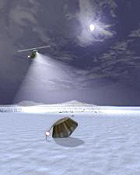How to Bring Home a Comet
On January 15, 2006, after more than 7 years and billions of miles of travel
through space, the Stardust spacecraft will finally return to Earth with some
precious cargo -- pristine samples of comet and interstellar dust. Stardust
will provide the world's first opportunity to analyze preserved samples of
the fundamental building blocks of our Solar System that formed 4.6 billion
years ago.

Retrieving the Sample Return Capsule
|
During a brief but daring encounter with Comet Wild 2 on January 2, 2004,
Stardust captured thousands of particles and began its arduous two-year
journey back to Earth, where its Sample Return Capsule (SRC) will land in
the Utah Test and Training Range (UTTR) within the Great Salt Lake Desert.
The SRC will reenter Earth's atmosphere and parachute toward the surface,
touching down at approximately 3:15 AM on January 15, 2006. Upon its long
anticipated landing, the SRC will separate from the parachute, which will
float on its own to the ground several yards away from the landing site.
After the capsule's touch down, three helicopters will begin their complex
task of retrieving Stardust's precious cargo. They will fly approximately
10 miles across the desert lakebed toward a UHF homing beacon emitted from
the capsule. The first helicopter, flown by a commercial pilot, will lead
the way; the second helicopter, a Blackhawk, will be flown by an Army
Reserve pilot; and lastly, the third, flown by another commercial pilot,
will bring up the rear of the helicopter fleet.
Accompanying the lead pilot will be UTTR's On-Scene Commander (OSCAR), as
well as a safety specialist from Lockheed Martin, the aerospace
corporation responsible for building the Stardust spacecraft. And in
order to ensure the most efficient and safe retrieval of the capsule, the
second helicopter will carry the recovery Operations Manager (RCO), a
Science Co-Investigator (Co-I) and a curation representative and recovery
specialist from Johnson Space Center (JSC).
Staggering their arrival to the landing site, the first helicopter's
navigation will unveil the exact location of the capsule and will begin
sweeping the SRC landing site with a spotlight to catch its reflection on
the dark desert floor.
Once the helicopters set down, the team will then begin the process of
preparing the SRC for its history-making analysis. First, a gas sample
will be taken and stored for preliminary examination. Then, the SRC will
be placed inside a handling fixture and double bagged to ensure that no
Earthly materials touch the capsule and contaminate its contents. Then,
the capsule will be flown to a prepared staging area cleanroom in a nearby hangar.
Just before entering the cleanroom, Lockheed Martin engineers, clad in
"bunny suits" will remove the SRC from its double bags, and take two more gas
samples from within the unopened capsule for further examination. Then,
because the capsule is encased in thick SLA-561 ablator materials that
protect it from the heat of reentry into Earth's atmosphere, the team will
have to drill into these protective coatings to access and remove the 12
bolts from the backshell of the capsule.
This is the first time that the SRC will be opened after its ambitious
encounter with Comet Wild 2 in 2004.
Deep inside the capsule is a canister that holds the samples--ancient comet
and interstellar dust particles that could hold possible clues to the early
origins of the Solar System. The canister loosely resembles an oversized
tennis racket and contains cells filled with Aerogel-- a substance so light
it almost floats in air. During the brief encounter with Comet Wild 2, the
sample tray with the Aerogel cells was exposed to capture the prized
particles, and then retracted into the canister for its long journey back to
Earth.
With great anticipation, the team will then carefully remove the canister
from the capsule.
Opening the Sample Return Canister
Stardust's Sample Return Canister will be opened at a curation facility at
JSC in Houston, Texas. It is here where science will again make history as
the very first pristine comet and interstellar dust samples will undergo
extensive investigation and analysis.
The fine dust and rocks in comets are best studied on Earth where complex
instruments can be used to fully study the materials at scales approaching
atomic spatial resolution.
Working in the cleanroom, scientists will painstakingly activate and slowly
open the canister, exposing the sample tray which holds the Aerogel and
trapped particles.
As a precaution, team members are prepared to catch any Aerogel pieces that
might have become loose during any part of Stardust's interstellar journey.
The sample tray will then be secured to a stand, and the individual Aerogel
capture cells will be removed from the sample tray with a cell-removal tool.
In order to minimize damage, each cell will be carefully removed and analyzed,
paying particular attention to unique features, composition, size, and
chemical properties. Each removed cell will be placed in an individually
marked box.
The need for laboratory study of samples from the Solar System's most
primitive bodies, was the inspiration for the NASA Stardust mission, the
first NASA mission to return samples from space since the Apollo 17 Lunar
mission in 1972.
These scientists will be the world's first to witness and analyze the
fundamental building blocks of our Solar System and may be able to determine
not only the origins of the Solar System from these samples, but also
possibly the origins of life.
Last updated November 29, 2005
|
|
